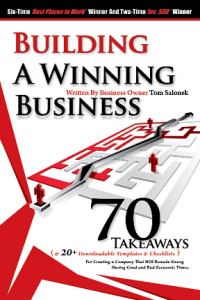15 Epic Tech Meltdowns You Won’t Believe
In the world of technology, anything can happen… from a botched speech to having to shoot down your own drones. Check out my post on the Intertech blog: 15 Epic Tech Meltdowns You Won’t Believe.

In the world of technology, anything can happen… from a botched speech to having to shoot down your own drones. Check out my post on the Intertech blog: 15 Epic Tech Meltdowns You Won’t Believe.
Below is an infographic from Intertech on what it takes to make a great workplace.
 Over the course of the next year, I’ll be posting all the parts of my book Building a Winning Business: 70 Takeaways for Creating a Strong Company during Good and Bad Economic Times.
Over the course of the next year, I’ll be posting all the parts of my book Building a Winning Business: 70 Takeaways for Creating a Strong Company during Good and Bad Economic Times.
I’m working on a Second Edition of the book and will boost the Takeaways to 100. If you thoughts on additional topics, leave a comment or fire me an email @ tsalonek at Intertech dot com.
.
.
—
Introduction
(When writing this book) My primary goal was to create a single source that shares “How we do stuff at Intertech” for new employees and clients. Whether you’re running your own company, managing an IT department within a multinational corporation, or leading a software development team, it’s my hope that some of the ideas and information presented here may work for you.
As an entrepreneur who has operated a successful IT development and training company, my experience includes work with many different employees and Fortune 500 companies, governmental agencies, nonprofits, and a good number of small- to medium-sized firms. In thinking about this book, I realized that despite their differences, all these organizations (including my own) are facing profound challenges—whether they realize it or not—due to the increasingly global nature of competition and what some are now calling “The Great Recession.”
One estimate from Forrester Research projects that by 2015 some 3.3 million professional positions will move offshore. Various economic prognosticators also are predicting the demise of entire industries as the inevitable outcome of the very entrenched economic downturn in which the world now finds itself.
On the employee side of the equation, things are also changing rapidly. Consider reputable predictions for Generation Y (as of 2010), which includes Americans older than five up to their early to mid-20s. Most will:
What does all of this mean?
Things are changing! The upcoming workforce is a generation unlike any other and will stretch us in how we attract and retain talent. Our competition can as easily come from Bangalore as Boston or Burnsville, Minnesota. An uncertain economy makes forecasting and growth challenging at best. Yet, I believe, all these changes are good in the long term. They force us to get better at serving our customers and employers, cultivating our employees (and ourselves), and understanding our markets. In essence, they compel us to build the strongest organizations possible to compete in the largely uncharted business waters of the 21st century.
This book is far from an ivory tower treatise, although it is an attempt to share the proven strategies I’ve gleaned from nearly 20 years in the business world. It includes lessons gathered from the perennial “school of hard knocks,” as well as valuable lessons I’ve learned from respected executive education programs, graduate-level classes, and ideas from fellow entrepreneurs at Harvard, the Massachusetts Institute of Technology, and the University of Minnesota’s Carlson School of Management. A business thinker of particular influence worth noting and thanking here is Verne Harnish, author of Mastering the Rockefeller Habits.
I’m certainly not a Stephen Covey or a Peter Drucker, but I have seen firsthand how effectively these strategies work at Intertech. Intertech has received more than 35 awards—for being one of the fastest-growing firms in America; for being one of the “best places to work,” according to Minneapolis/St. Paul Business Journal; and for excellence in our management practices. But the real proof is that Intertech has satisfied clients, great employees, and a profitable bottom line.
In The World Is Flat, Thomas Friedman notes that to compete in the future, “We have to do things differently. We are going to have to sort out what to keep, what to discard, what to adapt, where to redouble our efforts, and where to intensify our focus.”
I hope this book helps you to do just that.
—
Only 5% of busine ss break the $1M barrier. Of those, only one in eight breaks $10M in sales per year.
ss break the $1M barrier. Of those, only one in eight breaks $10M in sales per year.
What are the three big things that hold an entrepreneur back? Check out this great post from Verne Harnish on Fortune.com.
 As we enter 2014, Intertech and I have free learning opportunities and some new support programs for students:
As we enter 2014, Intertech and I have free learning opportunities and some new support programs for students:
Let’s make it a great ’14!
Tom